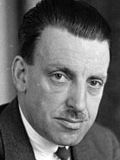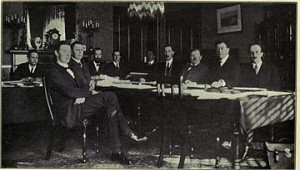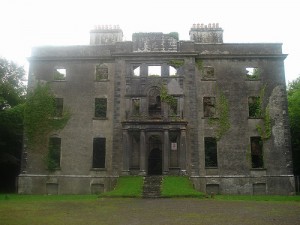‘Let it be Under our Thumb’ – the History of the Seanad

A brief history of the Irish Senate, By John Dorney.
In a recent (October 2013) referendum, the Irish electorate voted not to abolish the Seanad or Senate, Ireland’s Upper House of Parliament. The Seanad’s abolition was proposed by the governing coalition of Fine Gael and Labour and supported by a host of smaller parties, principally on the left, including Sinn Fein and the members of the United Left Alliance. It was opposed by Fianna Fail and a variety of independent voices, notably the former Minister for Justice Michael McDowell.
Among the criticisms levelled at the Seanad have been; that it is elitist – only around 1% of the electorate has a vote for it – that it is a waste of money (costing between €8 and €20 million annually depending on whose figures are to be believed) and that it essentially has no useful function. It has the right to comment on Bills passed in the Dáil (Ireland’s lower house) and to hold them up for 90 days, but not to block them.
Despite the low turnout in the referendum (around 40%) and the relatively close result (52%-48%), it seems clear that the electorate would prefer to see the Seanad reformed rather than abolished.
But what form should the renovation of the Seanad take? What is the history of the institution and what was its original purpose? This article is an attempt to answer these questions and to clarify debate about the future role of the Irish upper house.
The Home Rule Senate
The idea of second chamber of an Irish Parliament was included in the second Home Rule Bill of 1893, but this Bill was voted down in the British upper house, the House of Lords, and never got off the ground. The idea of the Senate was to ensure representation for Irish Protestants, many of whom, particularly in Ulster were against Irish self-government, in a country that was around 70% Catholic.
The Home Rule Bills envisaged a senate as representing the interests of the Irish Protestant minority.
By the time the Third Home Rule Bill was drafted in 1912, the powers of the House of Lords had been curtailed to merely delaying legislation passed in the House of Commons and this as a result was the first Home Rule Bill that actually became law (in August 1914). It was of course, never fully enacted. Ulster Unionist resistance, the First World War and Irish nationalist revolution all conspired to block it.
However for our purposes it is significant to note that the 1912 Home Rule Bill envisaged a significant role for a Senate in an autonomous Ireland. Under Home Rule Ireland would have had two houses of Parliament, a House of Commons, with 164 elected members and a Senate with 40 members nominated by the Imperial Parliament which was intended to represent the interests of the Protestant minority.
The Senate would have the right to hold up legislation and appeal it to the Imperial Parliament if not ultimately to block it. However given that the Imperial Parliament at Westminster could overturn any law passed in Dublin – according to the Prime Minister Asquith, ‘the over-riding force of the Imperial Legislation can at any time nullify, amend or alter any act of the Irish Parliament’ – the Senate’s power was significant.[1]
The last attempt to enact Home Rule in Ireland ( in 1920, another Government of Ireland Act) again proposed a Senate in both Northern Ireland and Southern Ireland. The Northern Senate lasted as long as the original Northern Ireland administration, until direct British rule was re-introduced in 1972. However the Southern senate was a short-lived affair, meeting only once in 1921 in the midst of the violent upheaval we now call the Irish War of Independence. It is nevertheless significant however as it heavily influenced the working of the first Irish Seanad, of 1922-33.
The Southern Ireland Senate had 64 members. Three were co-opted automatically by virtue of their office – the Lord Chancellor and the Mayors of Dublin and Cork. Seventeen were nominated by the Lord Lieutenant (the British monarch’s representative in Ireland) to represent, ‘commerce, labour and the learned professions’. Four were elected by the Catholic Bishops and two by the Protestant Church of Ireland. Another 16 were Peers or members of the British House of Lords, who would hold their seats by virtue of their hereditary titles. Eight were nominated by British Privy Councillors and 14 by Irish County Councillors. In short out of 64 Senators, only twenty would be elected in Ireland. [2]
The 1920 Senate had a short shelf life. It was ignored by Sinn Fein, the separatist party now in the ascendant in Irish politics, who won 124 out of 128 seats (unopposed) to the Southern Ireland House of Commons but who boycotted it, arguing that it legitimised British rule and that the Irish Republic declared in 1919 had already superseded it. Only five Senators turned up at the opening of the Southern Ireland Parliament in June 1921 and it never met again. It was wound up with the signing of the Anglo-Irish Treaty in December 1921.
The making of the Free State Seanad, 1922

The Anglo-Irish Treaty, signed on December 6 1921, made no mention of the form of government the newly created Irish Free State would have. This was left to the Irish authorities who were to draw up a constitution for the Free State which would in turn have to be approved by the British Parliament.
Michael Collins and Arthur Griffith, heads of the Provisional Government set up to hand over from the British to the Free State, formed a committee in early 1922 to draft a new constitution. However, with furious divisions arising in the Irish republican movement over the Treaty that would eventually end in Civil War between those who accepted the Free State and those who held out for a Republic, agreeing a constitution proved no easy task.
The 1922 constitution created a directly elected Senate and gave it considerable powers.
Several drafts, intended to appease the anti-Treatyites by removing the clause compelling Irish Parliamentarians to take an Oath of allegiance to the British King were vetoed by the British government.
It was not until October of 1922, with both Collins and Griffith dead the Civil War well underway that the first Irish constitution was actually drawn up by the Free State authorities.
Like the Home Rule Bills that had preceded it, the 1922 constitution envisaged a two house Parliament. The Dáil, directly elected by all citizens over 21 would enact legislation while a senate or Seanad, 60 strong, would represent various social groups – according to the constitution; ‘citizens who shall be proposed on the grounds that they have done honour to the Nation by reason of useful public service or that, because of special qualifications or attainments, they represent important aspects of the Nation’s life’ – and oversee that legislation.
Unlike the Home Rule senate, the first Seanad was envisaged as a quite democratic body. The constitution stated, ‘All citizens of the Irish Free State (Saorstát Eireann) without distinction of sex who have reached the age of thirty years and who comply with the provisions of the prevailing electoral laws, shall have the right to vote for members of Seanad Eireann’[3].
The candidates would first be selected by the Dáil and the existing Seanaid members. A quarter of the Seanad’s members would face re-election every three years.
The powers of the first Seanad were limited compared to the Dáil but considerably more extensive than senates since 1937. It could send back a Bill from the Dáil with which it did not agree and, in the event that the Dáil continued to pass it, to hold up the Bill for 277 days or nine months. The exception to this was a ‘money bill’ – anything in other words connected with taxation or public finances – which it could only hold up for 21 days. Unlike later Seanads, it had the right initiate legislation, which if passed in the senate would come before the Dáil and if passed there, become law.[4]
The Free State Seanad in practice, 1922-1933

While the Constitution envisaged a directly elected senate, this was not possible in late 1922, with Civil War raging across much of the country. Instead the first Seanad was half nominated by the President of the Dáil, (prime minister) WT Cosgrave and half elected by members of the Dáil.[5]
As a result of this, the senate in fact quite closely resembled the Home Rule Senate of 1920 and former unionists and holders of British hereditary titles were notably represented.
The Cathaoirleach or chairman of the new senate, for instance was James Campbell, Baron Glenavy, who was a former unionist MP for Dublin, Lord Chief Justice for Ireland and who had participated in Ulster resistance to Home Rule back in 1912.
Cahir Davitt the Free State’s attorney general recalled; ‘On December 6th the Irish Free State had come into being when Its Constitution was enacted by the Dáil sitting as a Constituent Assembly. The first Senate came into existence …by being partly elected and partly nominated as provided by the Constitution and held its first meeting on December 9th under the Chairmanship of Lord Glenavy.[6]
In early 1923 the anti-Treaty IRA mounted a sustained campaign against the Senate. In 1933 their political descendants in Fianna Fail abolished it altogether.
The Seanad could not avoid the horrors of the Civil War. Two days before its first meeting four prominent anti-Treaty republican leaders had been executed in retaliation for the assassination of Sean Hales TD.
According to Davitt; ‘There were no further “executions” of members of the Dáil but the wholesale destruction of property proceeded apace, and business premises and private residences of persons associated with the Government or the legislature came in for special attention’.[7]
The Senate was a particular victim. On 26 January 1923, the anti-Treaty IRA Adjutant General (effectively second in command) Con Moloney issued the following order.
1. Houses of members of ‘Free State Senate’ in attached list marked A and B will be destroyed.
2. From the above date if any of our Prisoners of War are executed by the enemy one of the Senators in the attached list…will be shot in reprisal.[8]
Moloney attached a list of the names of 20 Senators and their addresses. Of these, 14 on list A were liable for possible assassination. Campbell or Glenavy the Chairman was not among them, though his home was marked for destruction. However those marked for death included ‘John Bagwell, General Manager Great Northern Railway, Imperialist and Freemason’ , Henry Wilson, ‘heir to the Marquis of Lansdowne, Imperialist and Freemason’, Andrew Jameson, Chairman of Bank of Ireland and Bryan Mahon Commander in Chief of British force in Ireland 1916-18 ‘Imperialist and Freemason’. [9]
The list tells of something of republican prejudices. Those marked for death were disproportionately upper class ‘Anglo-Irish’ Protestants either of landed or big business backgrounds. However it also tells us something of the nature of first Free State senate that so many of its members had occupied such senior social and political positions in British ruled Ireland.
In the event no senators were actually killed by the IRA in the Civil war despite ongoing executions of their men by the Free State government. However there was a wholesale campaign of destruction undertaken against senator’s houses. Out of 199 ‘Big Houses’ or mansions destroyed by the republicans as reprisals, 30 belonged to senators. [10] There were also several attempts to abduct and perhaps kill some of those on the list mentioned above. Senator John Bagwell, for instance was kidnapped at gunpoint from his house in Howth in Dublin and only released when the Free State threatened to execute several imprisoned republican leaders if he were killed. [11]
The Seanad therefore limped through the Civil War, an unelected and traumatised body. However it did see a number of notable debates in the following years. In June 1925 the poet and senator WB Yeats railed against the banning of divorce, claiming that it would alienate Irish Protestants from the state and ‘crystallise’ the partition of Ireland. Yeats also famously weighed in against the new censorship laws against ‘immorality’ in literature that were being brought in under the Free State.
In September 1925 the Seanad had its first elections. In the face of a boycott by supporters of the anti-Treaty Sinn Fein, only around 25% of the electorate turned out to vote for 76 candidates and the voters re-elected only 8 of the existing senators nominated in 1922. Most former unionists lost their seats and the Seanad was now dominated by the representatives of the pro-Treaty ruling party, Cumann na nGaedheal, followed by the Labour Party and the Farmers’ Party.
Already the Seanad had effectively lost its original purpose of providing minority representation – an inevitable consequence of its being directly elected. However it remained a bastion of pro-Treaty support and when Fianna Fail, the party that split from Sinn Fein in 1926 and entered the Dáil in 1927 to represent anti-Treaty interests, came to power in 1932, the Seanad again became a battleground.

In 1932, Fianna Fail abolished in the Dáil the Oath of Allegiance to the British monarch. The Seanad, as was its right, voted down the Bill and returned it to the Dáil. This caused Fianna Fail leader Eamon de Valera to call an election, in which his party won an overall majority. When the requisite 277 days were up, the Removal of the Oath Bill duly passed into law in May 1933. From this point onwards the first Seanad’s days were numbered.[12]
Its fate was sealed the following year. With rioting taking place around Ireland between Fianna Fail and IRA supporters on the one hand and the quasi-fascist Treatyite Blueshirt movement on the other, the Fianna Fail government passed a law banning the wearing of uniforms – effectively illegalising the Blueshirts. The Senate again voted down the Bill, delaying its passing by nine months. However de Valera then simply passed another Bill to abolish the senate. Though predictably not passed in the Upper House, after 277 days, in late 1934, the first Seanad ceased to exist.[13]
The second Seanaid 1937-present

For nearly three years thereafter the Irish Free State had no upper house.
However in 1937, when introducing his new constitution – still the basis of law in Ireland today – de Valera set up a new Seanad. This one, its creators were determined, would not obstruct the powers of the lower house as had its predecessor. Many Fianna Fail supporters had regarded the old senate as a bastion of pro-British privilege. Sean Lemass, one of de Valera’s most able lieutenants said, ‘if there is to be a second house, let it be a second house under our thumb’.[14]
As a result although the inspiration for the new senate was the idea of ‘vocationalism’ (prominent in Catholic social teaching at the time) whereby social groups such as employers, labour, farmers and others would be represented, in practice the new senate had little independence.
It had 60 members and had the same lifespan as the Dáil. Of these, 43 were from ‘vocational panels’ but were in fact nominated by sitting TDs – albeit in some cases after first being put forward by groups such as trade unions and employers’ associations – and then elected, not as previously by the electorate but by city and county councillors. Another 11 members were nominated directly by the Taoiseach (prime minister). The Universities (more specifically the National Universities and Trinity College Dublin) nominated six senators, who were elected by university graduates. In practice therefore, the Seanad was to be tightly controlled by whichever party controlled the Dáil. Many of the seats became jobs for either aspiring or retiring politicians.[15]
In three areas the Seanad has equal powers with the Dáil – the declaration of a national emergency, the impeachment of a President and the removal of a judge all require the approval of both houses.
The 1937 Seanad, unlike its predecessor, is not directly elected and can only hold up Bills for a maximum of 90 days.
However, unlike its predecessor, the 1937 Seanad cannot initiate legislation and can only hold up Bills for 90 days. If the Bill is again passed by the Dáil, in theory the Seanaid can then go to the President, petition him not to sign the Bill and to hold a referendum on it. However this has never happened and in fact the Seanad has not rejected a Dáil Bill since 1964.[16]
The future?
Since the Seanad in its current form has never had any real power (arguably indeed it was designed with this in mind in 1937), calls for its abolition are understandable. Other small democratic countries have abolished their upper houses without notable consequence – for instance Denmark in 1953, New Zealand in 1950 and Sweden in 1970.
The electorate clearly wants the senate to be more relevant and more representative.
However defenders of the Seanad argue that the non-partisan atmosphere there can lead to more enlightened debates over legislature than can happen in the lower chamber. They argue that especially those from outside politics such as the University senators make a contribution to debates that would not otherwise happen and which improve law-making in Ireland. David Norris, a long time senator from Trinity College, for instance was almost a lone champion of gay rights in Irish politics in the 1980s and early 1990s.
However no one denies that the Seanad in its current form is undemocratic and in need of reform. So what form should this take? If the Seanaid were directly elected on an open nomination, it would have the same mandate as the Dáil, but none of its powers – a fairly useless duplication.
If the panels were nominated by the Dáil on the basis of vocational panels and then elected by the public the Seanad would be closer to the 1922 model than that of 1937. Somewhat ironically, given the party’s history with the institution, this seems to be the solution favoured by Fianna Fail. These debates all lie in the future. However what seems clear is that the electorate is wary of simply abolishing an arm of government altogether and favours making it more relevant and more representative.
References
[1] Alvin Jackson, British Ireland, In Niall Ferguson ed. Virtual History Penguin 2011 p195
[2] John Coakley, Michael Gallagher, Politics in the Republic of Ireland, (1999) p15
[3] The 1922 Irish Constitution, online here http://www.irishstatutebook.ie/1922/en/act/pub/0001/print.html
[4] 1922 Irish Constitution
[5] Charles Townshend, Ireland, the Twentieth Century, Hodder 1998, p118
[6] Cahir Davitt WS BMH
[7] Davitt BMH
[8] Cormac O’Malley, Anne Dolan (eds) No Surrender Here! The Civil War Papers of Ernie O’Malley, 533
[9] Ibid.
[10]Terence Dooley, Decline of he Big House in Ireland, p189
[11] Anglo-Celt February 3, 1923 Dail Eireann debate 31 January 1923. http://historical-debates.oireachtas.ie/D/0002/D.0002.192301310015.html
[12] Townshend, Ireland The Twentieth Century, p137
[13] Dermot Keogh, Twentieth Century Ireland, Nation and State, p84
[14] Townshend Ireland the Twentieth Century, p145
[15] Coakely, Gallagher, Politics in the Republic of Ireland p198
[16] Ibid. p200